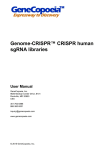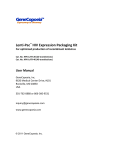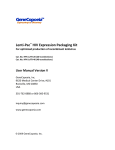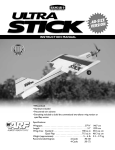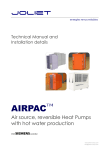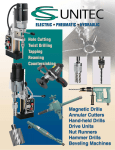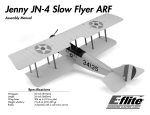Download Electra OU7-24T RC Instruction manual
Transcript
TM TM INSTRUCTION MANUAL • Assembly time 3–5 hours • Foam construction • Stable, sporty flight characteristics Specifications Wingspan: . . . . . . . . . . . . . . . . . . . . . 33.25" (844.6 mm) Overall Length. . . . . . . . . . . . . . . . . . . . 29" (736.6 mm) Ready-To-Fly Weight. . . . . . . . 16–24 oz (436.6–680.4 g) Radio (not included) . . . . . . . . . . . . 3-channel minimum Battery Pack (not included) . . . . . . . . . . . . . . . . . . . . . . . . . . . . . . . . . . . . . 8-cell 600mAh pack recommended Speed Controller (included). . . . . . . . . . . . . . . . . . . . . . . . . . . . . . . . . . . . . . . minimum 15-amp recommended Table of Contents Introduction . . . . . . . . . . . . . . . . . . . . . . . . . . . . . . . . . . . . 2 Assembly Tips . . . . . . . . . . . . . . . . . . . . . . . . . . . . . . . . . . . 2 Kit Contents . . . . . . . . . . . . . . . . . . . . . . . . . . . . . . . . . . . . 3 Required Additional Equipment . . . . . . . . . . . . . . . . . . . . . . 3 Assembling the Main Wing and Servos . . . . . . . . . . . . . . . . 4 Installing the Motor Mount . . . . . . . . . . . . . . . . . . . . . . . . . 7 Assembling the Vertical Stabilizers . . . . . . . . . . . . . . . . . . . . 8 Assembling the Canopy and Hatch . . . . . . . . . . . . . . . . . . . . 9 Assembling the Motor and Propeller . . . . . . . . . . . . . . . . . 10 Installing the Speed Controller and Delta Mixer . . . . . . . . . 11 Assembling the Tail Fin and Servo Connectors . . . . . . . . . . 12 Battery Charger . . . . . . . . . . . . . . . . . . . . . . . . . . . . . . . . . 13 Prior to First Flight . . . . . . . . . . . . . . . . . . . . . . . . . . . . . . 13 Flight Safety . . . . . . . . . . . . . . . . . . . . . . . . . . . . . . . . . . . 13 AMA Safety Code . . . . . . . . . . . . . . . . . . . . . . . . . . . . . . . 14 ElectraJet Spare Parts List . . . . . . . . . . . . . . . . . . . . . . . . . 15 Glossary of Terms . . . . . . . . . . . . . . . . . . . . . . . . . . . . . . . . 15 Introduction Congratulations! You have purchased the E-Flite™ ElectraJet™, a high-quality, electric ARF (Almost-Ready-To-Fly) R/C park flyer. If you are able to successfully fly a trainer-type R/C airplane on your own, you should feel confident flying your electric ElectraJet. Please take into consideration that smaller, lightweight park flyers like the ElectraJet fly best with no wind or very light wind conditions. If you are a first time R/C pilot, seek the guidance of an experienced R/C pilot before flying your ElectraJet. Flying with a more experienced R/C flyer may prevent an unfortunate and untimely loss of your airplane, as well as prevent possible injury to you or spectators or damage to property. The hobby shop where you purchased this kit may be able to recommend a local R/C flying club that you could join. R/C flying clubs often have very experienced R/C pilots who are happy to provide guidance to less-experienced R/C pilots who would like to develop flying skills. R/C flying clubs also have dedicated R/C flying sites, which are best choices for flying any type of R/C aircraft. We hope your E-Flite ElectraJet brings you may hours of R/C flying enjoyment. Thank you for purchasing this E-Flite product. WARNING An R/C aircraft is not a toy! If misused, it can cause serious bodily harm and damage property. Fly only in open areas, preferably AMA (Academy of Model Aeronautics) approved flying sites. Follow all included instructions. Assembly Tips Carefully read assembly instructions and inspect all parts prior to assembly. In the assembly instructions, the left and right of the airplane refer to the left and right side, as if you were stationed in the cockpit. Use 12-minute epoxy and silicone sealant for model assembly. Moderate, but not excessive, amounts of adhesive are recommended. Remember to use what you need and no more. It is important to keep park flyers light, adhesives add weight. Build you model on a solid, flat surface in a well lit and well ventilated location. 2 If you are an inexperienced builder, we recommend seeking the guidance of a more experienced model builder to help you assemble the kit. If you encounter difficulty in any construction sequence, please contact one of our technicians at Horizon Hobby, Inc. 4105 Fieldstone Road Champaign, IL 61822 (877) 504-0233 www.horizonhobby.com Kit Contents Carefully examine the contents of this kit before you start the assembly process. It is recommended that you carefully read through this instruction manual before you start assembly. 9 6 11 10 12 13 1 14 8 15 2 1 2 3 4 5 3 Fuselage Canopy Motor Cover Left Wing Panel Right Wing Panel 4 7 5 6 7 8 9 10 16 Vertical Fins (2) Everons (2) Hardware Package Canopy hatch Dorsal Fin 11 Speed Controller (EFLA100) 12 Delta Mixer (EFLA101) 13 Motor + Gearbox 14 Prop Nut 15 Set Screw 16 Propeller Required Additional Equipment Tools and Supplies Needed (not included in kit) • Sharp hobby knife • Double-sided servo tape • Round file (small) • Velcro® Tape • Needle-nose pliers • Masking tape • Wire cutters • Black felt-tipped pen or pencil • Phillips screwdriver • Flat-head screwdriver (medium)not included • 1.5mm Allen wrench • Sanding block with fine grit sandpaper • Ruler • Drill • Drill Bit: 1/8" • 12-minute epoxy • Rubbing alcohol • Odorless CA • Clear silicone sealant Recommended Radio and Electronic Equipment The best choice for your airborne radio equipment would be the JR AirPac Micro (JRPF640), which combines two JR S241 Sub-Micro servos and one JR R610 6-channel FM micro receiver into one package. Total weight for this three-piece package is just over one ounce. An 8-cell 600mAh battery pack in kit) A speed controller is included in the kit, as is the V-tail mixer in the deluxe kit (EFLA1000). The best choice for your speed controller is E-Flite 16-Amp Electric Speed Control (EFLA100). If you do not have a radio that has delta mixing capabilities, you can purchase a Delta Mixer for the standard kit (EFLA101). 3 Assembling the Main Wing and Servos Step 1. Use a sanding block with fine sandpaper (preferably 400 grit) to remove the flashing from the areas that glue will be applied on all foam parts. (Please read ahead to find out where glue will be applied.) Step 2. Trial fit the wings (both the left and right panel) onto the fuselage. When you are satisfied with the fit, mix an adequate amount of 12-minute epoxy and apply the epoxy to the wing joiner slots (located on the fuselage) onto the main wings. Step 3. Position the wing panels onto the fuselage and use masking tape to hold the wing joints together while the epoxy cures. Wipe off any excess epoxy using rubbing alcohol and a paper towel. Make sure that the wing panels are perpendicular to the fuselage. Please note that the masking tape may alter the finish slightly. Allow the epoxy to cure completely. 4 Step 4. Trial fit the hinges that will be placed into the wing for the Elevons. Mix an adequate amount of 12-minute epoxy. Apply to one side of the hinges on the horizontal wing. Use very small amounts of epoxy when installing the hinges. If epoxy gets into the hinge points, clean off the epoxy using rubbing alcohol. Step 5. Apply small amounts of epoxy to the other side of the hinges on the horizontal wing. Remember to keep the hinge points clear of epoxy. Step 6. Insert elevons onto wing. Step 7. Please locate the indentations made on the elevons for the control horns. Install the control horns to the elevons using 12-minute epoxy. Allow the epoxy to cure completely. Step 10. Use a 2.0-mm drill bit to open up the holes in the servo arm of each servo. Step 8. Locate two micro servos and two sets of pushrod connectors. Step 11. Insert the pushrod connectors into the holes in the servo arms, but do not tighten the servo arm down at this time. Step 9. Attach double-sided servo tape to each of the micro servos. Step 12. Allow the connectors to be free to move. Step 13. Using a wire cutter or metal snip, trim the excess plastic away from the servo control arm on each servo. A sharp hobby knife will also work. 5 Step 14. Remove the backing of the servo tape on the servos. Step 17. Insert the other end of the Z-bent rod into the pushrod connector. It will be helpful to use small pieces of masking tape to hold the ailerons at the 0-degree deflection (centered on airfoil of wing) while the control rods are being attached to the servo arms. Step 15. Mount the servos and cables into each of the recesses in the wings. Step 18. With the servo arm centered and ailerons at neutral (0 degrees deflection up or down), tighten the pushrod connectors with the hex driver provided. Step 16. Insert the Z-bent rod into each control horn of the ailerons in the wing. 6 Installing the Motor Mount Locate all motor mount parts as located in the picture below. Step 1. Assemble the motor mount, but do not glue any of the motor mount parts together! Step 3. Apply epoxy to the motor mount recesses located in the center of the fuselage and install the motor mount to the fuselage. Step 4. Use masking tape to hold the motor mount in place on the fuselage. Step 2. Mix an adequate amount of 12-minute epoxy and apply to the dowels. 7 Assembling the Vertical Stabilizers Step 1. Locate the two vertical stabilizers. Step 2. Mix an adequate amount of 12-minute epoxy and apply to the recesses on the fuselage where the vertical stabilizers will be mounted. Step 3. Use a pin to hold the vertical stabilizers in place. (Masking tape can also be used, but remember it can mark the surface of the foam). 8 Step 4. The distance between the leading edge of the vertical stabilizers is 215 mm. Step 5. Wipe off any excess epoxy with rubbing alcohol and paper towels. Assembling the Canopy and Hatch Step 1. Remove the flashing around the hatch with a sharp hobby knife. Step 2. Mix an adequate amount of 12-minute epoxy and apply to the recess in hatch (which is located at the rear of the hatch) and to one plywood square hold-down. Step 5. Mix an adequate amount of 12-minute epoxy and coat the underside on the plastic latch. Step 6. Place the plastic latch onto the fuselage and glue in place. Step 7. Using 12-minute epoxy, glue the hatch-latch recepticle in place. Step 3. Mount the plywood hold-down to the hatch. Step 4. Assemble the plastic hatch latch. Step 8. Locate the clear canopy from the kit contents. If needed, trim the canopy to fit onto the hatch. Place a bead of odorless CA around the canopy edge and place it onto the foam hatch as seen in the picture below. If needed, hold the canopy in place using masking tape. 9 Assembling the Motor and Propeller Step 1. Locate the spinner, aluminum nut, set screw, and propeller from the kit contents. Step 2. When you insert the nut into the propeller, the printing on the 8"x4" propeller must face toward the gearbox of the motor when it is mounted to the motor. Step 3. Use a propeller wrench to secure the spinner, aluminum nut, and propeller to the propeller shaft. 10 Step 4. Use the 1.5 mm hex wrench to tighten the grub screw of the aluminum nut to the propeller shaft of the motor/gearbox (please note that the set screw will thread onto the flat spot on the shaft). Step 5. Secure the motor to the motor mount on the fuselage with the four small rubber bands provided. Step 6. Secure the cowling of the motor to the motor mount with several small rubber bands. Installing the Speed Controller and Delta Mixer Step 1. Glue the Velcro® strip to one side of the fuselage. This will be used to secure the battery in the fuselage. Step 4. Pass the delta mixer wires out through the fuselage onto the wing, as shown in the picture below. Step 2. Locate the receiver, speed controller and delta mixer. Please refer to the instructions provided with the speed controller and delta mixer for an outline of the installation steps and drawings of wiring and hook-up schematics. STEP 5. With the receiver in the forward part of the fuselage, pass the antenna through an opening in the fuselage in a similar manner as the delta-mixer. Note that both the delta mixer and the receiver are mounted forward of the battery in the fuselage. Double-sided servo tape can be used to secure both to the fuselage. Step 3. Before connecting the speed controller and delta-mixer, use a sharp hobby knife to carve two small tunnels at the bottom of the wing for the delta mixer connectors to slip between the fuselage and the wing. Connect the delta mixer to the receiver at this time. Temporarily position them in the forward part of the fuselage. Step 6. Place a piece of double-sided tape on the On/Off switch and position it in the AFT part or the fuselage behind the battery. 11 Assembling the Tail Fin and Servo Connectors Step 1. Make sure the power switch is off and that the battery is not connected before you connect the motor and speed control plug. Warning: Always assume the motor can come on at any time. Be absolutely certain no power is connected to the motor while you are working around it. Step 5. Fix the servo wires to the wing with the 10 mm sticker tape provided Step 2. Now is the time to install the bottom vertical fin with odorless CA, as shown in the picture below. Step 6. Use the box as a reference when applying the decals to the aircraft. Step 3. Connect the servo leads to the delta-mix connectors located near the fuselage. Step 4. Fix the antenna cable on the main wing with the 10 mm sticker tape provided. This sticker tape is located on the decal sheet and is grey in color. This decal will have to be cut into three strips as it will be used to cover the servo leads and the receiver antenna. 12 Step 7. Check the center of gravity of your model. Place the battery pack inside the fuselage so that the model will balance properly. When the desired location is found, place the battery inside the canard using double-sided servo tape. Please note that the battery mounts between two pieces of foam which are molded into the fuselage. These two pieces may have to be trimmed depending on the battery of your choice. Battery Charger Refer to the instruction sheet provided with the charger. CAUTION It is important you read the instructions for proper operation of the charger before you attempt charging the battery. Failure to do so could result in injury or damage to property. Prior to First Flight Step 1. Ensure that all electronic and radio equipment is properly installed and connected and that the battery is charged. Step 4. Check for proper movement of the elevons and speed controller. At a standard rate the control throws for the elevons should be 1/4" up and 1/4" down. Step 2. Make sure the motor is attached securely to the fuselage. Step 3. Check the center of gravity. The center of gravity should be located 8 1/2"–8 3/4" behind the leading edge of the wing. Step 5. Range check your ElectraJet™ prior to the first flight or the first flight after a repair. With the transmitter antenna retracted, walk 30–40 paces from the model. With the assistance of another person, check for the proper operation and movement of the control surfaces and speed control. Caution: Remember to keep your hands and face clear of the propeller! 8 1/2" Flight Safety • Always take off and land into the wind. • If you are an inexperienced R/C pilot, do not fly unless you have an experienced R/C pilot with you. • Never fly on or near a road with traffic. You may risk a collision with an automobile or you may distract a driver, which may cause an accident. • Be sure to follow the AMA Safety Code on the following page. • Fly only in open areas free of obstructions and never fly over spectators. Your flying area should be clear of trees, buildings and power lines. 13 AMA Safety Code 2001 Official AMA National Model Aircraft Safety Code Effective January 1, 2001 Model flying must be in accordance with this code in order for AMA liability protection to apply. General 1. I will not fly my model aircraft in sanctioned events, air shows, or model flying demonstrations until it has been proven to be airworthy by having been previously, successfully flight tested. 2. I will not fly my model higher than approximately 400 feet within 3 miles of an airport without notifying the airport operator. I will give right-of-way and avoid flying in the proximity of full-scale aircraft. Where necessary, an observer shall be utilized to supervise flying to avoid having models fly in the proximity of full-scale aircraft. 3. Where established, I will abide by the safety rules for the flying site I use, and I will not willfully and deliberately fly my models in a careless, reckless, and/or dangerous manner. 4. At all flying sites, a straight or curved line(s) must be established in front of which all flying takes place, with the other side designated for spectators. Only personnel involved with flying the aircraft are allowed in front of the flight line. Flying over the spectator side of the line is prohibited, unless beyond the control of the pilot(s). In any case, the maximum permissible takeoff weight of the models with fuel is 55 pounds. 5. At air shows or model flying demonstrations, a single straight line must be established, one side of which is for flying and the other side for spectators. Only those persons accredited by the contest director or other appropriate official as necessary for flight operations or as having duties or functions relating to the conduct of the show or demonstration are to be permitted on the flying side of the line. The only exceptions which my be permitted to the single straight line requirements, under special circumstances involving consideration of side conditions and model size, weight, speed, and power must be jointly approved by the AMA President and the Executive Director. 6. Under all circumstances, if my model weighs over 20 pounds, I will fly it in accordance with paragraph 5 of this section of the AMA Safety Code. 7. I will not fly my model unless it is identified with my name and address or AMA number, on or in the model. Note: This does not apply to models while being flown indoors. 8. I will not operate models with metal-bladed propellers or with gaseous boosts, in which gases other than air enter their internal combustion engine(s); nor will I operate models with extremely hazardous fuels such as those containing tetranitromethane or hydrazine. 9. I will not operate models with pyrotechnics (any device that explodes, burns, or propels a projectile of any kind) including, but not limited to, rockets, explosive bombs dropped from models, smoke bombs, all explosive gases (such as hydrogenfilled balloons), ground mounted devices launching a projectile. The only exceptions permitted are rockets flown in accordance 14 with the National Model Rocketry Safety Code or those permanently attached (as per JATO use); also those items authorized for Air Show Team use as defined by AST Advisory Committee (document available from AMA HQ). In any case, models using rocket motors as primary means of propulsion are limited to a maximum weight of 3.3 pounds and a G series motor. Note: A model aircraft is defined as an aircraft with or without engine, not able to carry a human being. 10. I will not operate any turbo jet engine (axial or centrifugal flow) unless I have obtained a special waiver for such specific operations from the AMA President and Executive Director, and I will abide by any restriction(s) imposed for such operation by them. (Note: This does not apply to ducted fan models using piston engines or electric motors.) 11. I will not consume alcoholic beverages prior to, nor during, participation in any model operations. Radio Control 1. I will have completed a successful radio equipment ground range check before the first flight of a new or repaired model. 2. I will not fly my model aircraft in the presence of spectators until I become a qualified flier, unless assisted by an experienced helper. 3. I will perform my initial turn after takeoff away from the pit or spectator areas, and I will not thereafter fly over pit or spectator areas, unless beyond my control. 4. I will operate my model using only radio control frequencies currently allowed by the Federal Communications Commission. (Only properly licensed amateurs are authorized to operate equipment on Amateur Band frequencies.) 5. I will not knowingly operate an R/C system within 3 miles of a pre-existing model club-flying site without a frequency sharing agreement with that club. 6. Models flown in air-to-air combat are limited to maximum total engine displacement of .30 cubic inches and a maximum dry weight prior to flying of 4 pounds. Organized RC Racing Event 7. An RC racing event, whether or not an AMA Rule Book event, is one in which model aircraft compete in flight over a prescribed course with the objective of finishing the course faster to determine the winner. In every organized racing event in which contestants, callers and officials are on the course: All officials, callers and contestants must properly wear helmets which are OSHA, DOT, ANSI, SNELL or NOCASE approved or comparable standard while on the race course; All officials will be off the course except the starter and his/her assistant. “On the course” is defined to mean any area beyond the pilot/staging area where actual flying takes place. B. I will not fly my model aircraft in any organized racing event which does not comply with paragraph A above or which allows models over 20 pounds unless that competition event is AMA sanctioned. ElectraJet™ Spare Parts List • Wing Replacement (EFL1001) • Fuselage Replacement (EFL1002) • Tail Replacement (EFL1003) • Hardware Kit (EFL1004) • Speed Controller (EFLA100) • Delta Mixer (EFLA101) • Propeller (EFLA300) • Power Unit (EFLA400) Glossary of Terms Activating (Arming) Switch: An external switch that prevents the electric motor from accidentally turning on. Axis: A line passing through a body about which the body revolves. Battery cycling: The repeated charge and discharge of a battery to erase battery memory. Battery Memory: Term used to explain why a battery is unable to take on a full charge because of insufficient discharging before recharging. Capacity: The amount of charge or electricity a battery can hold. Center of Gravity (CG): Balancing point of an aircraft. Center Line: An imaginary line drawn through the center of the aircraft from the nose through the tail. Control Horn: The arm on the control surface that connects with the pushrod. Control Surface: The moveable parts on the wing and tail that cause the aircraft to roll (ailerons), pitch (elevator), or yaw (rudder). Dihedral: The degree of angle (V-shaped bend) at which the wing intersects the airplane is called dihedral. More dihedral gives an airplane more aerodynamic stability. Some small R/C airplanes and trainers with large dihedral dispense with ailerons and use only the rudder to control roll and yaw. Electrolyte: A caustic material found in batteries. Elevator: The hinged control surfaces connected to the horizontal stabilizer. The elevator controls the pitch of the airplane. On a Mode II transmitter, pulling the right control stick back makes the elevator move up and the airplane will nose up and try to climb. Pushing the right control stick forward moves the elevator down and causes the nose of the aircraft to go down and the airplane to descend. Fuselage: The main body of the airplane. Harness: A device consisting of wires, switches, and a fuse that connects the motor to the battery. Horizontal Stabilizer: The horizontal surface of the tail that provides stability in flight. The elevator is connected to the horizontal stabilizer. Leading Edge: The front edge of a flying surface (wing, horizontal stabilizer, and vertical stabilizer). Landing Gear: The wheel and gear assembly the airplane uses to land. It is attached to the bottom of the fuselage or wings. Nicad (Nickel Cadmium) battery: A rechargeable battery used for radio control airplanes. Pitch Axis: Degree of nose up or nose down from level to the horizon. Pushrod: The rigid wire that transfers movement from the servo to the control surface Receiver: The receiver unit in the airplane receives your signals from the ground transmitter and passes the instructions to the servos in the airplane. Roll Axis: The horizontal plane on which the airplanes wingtips are raised or lowered. The airplanes ailerons cause the airplane to roll left or right. On some smaller airplanes that do not have ailerons, application of the rudder control, combined with the wing dihedral, will cause the airplane to roll. Rudder: The control surface attached to the vertical stabilizer. The rudder controls the yaw of the airplane (movement of the nose of the aircraft left or right). Moving the left control stick of the transmitter left or right causes the rudder to move left or right. Servo: The servo transforms your ground commands into physical adjustments of a control surface while the airplane is in flight. Servo Arm: The moveable arm or wheel that connects the servo to the pushrod (also called a servo horn). Span: The maximum distance from wingtip to wingtip. Speed Controller: An electronic device that functions as a throttle for an electric motor. A speed controller controls the speed or rpm of an electric motor. Stall: Loss of lift resulting from exceeding the critical angle of attack of the wing. Transmitter: The device used on the ground to transmit instructions to the airplane. Three transmitter modes are used in model airplanes. The most common is Mode II where the left stick controls the throttle and rudder and the right stick controls the elevator and ailerons. Vertical Stabilizer: One of the tail surfaces that provides stability in flight. The rudder is connected to the vertical stabilizer. V-Tail: Combines the function of the elevator and ailerons into one function, usually through an electronic mixer or through a preset mix in the transmitter. Wing: The wing provides the primary lifting force on an airplane. Yaw Axis: The vertical plane through which the airplanes nose passes as it yaws to the left or right. The rudder controls movement around the yaw axis. Z-Bend: The end of a pushrod wire with a “Z” shaped bend that connects to the servo. 15 © Copyright 2001, Horizon Hobby, Inc. www.horizonhobby.com
















